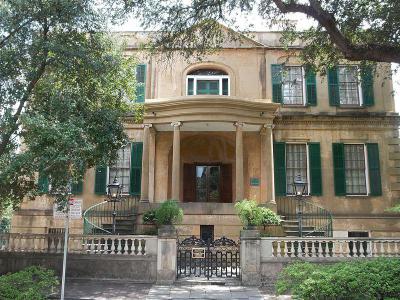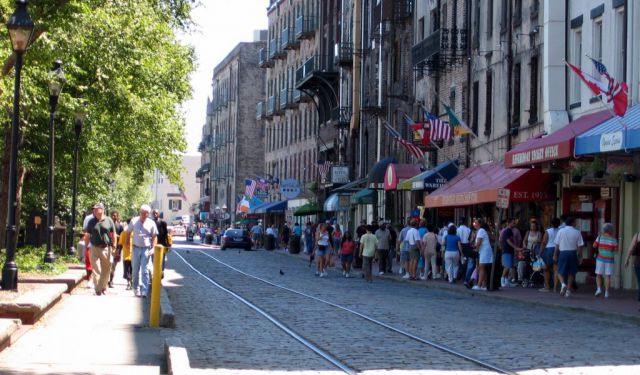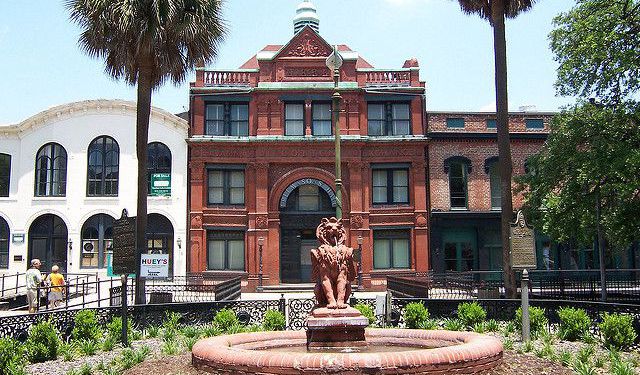
Owens-Thomas House and Slave Quarters, Savannah (must see)
The historic Owens–Thomas House in Savannah, Georgia is one of the finest examples of English Regency architecture in the United States.
The building was completed in 1819 to a design by William Jay, an English architect. His plan was to create a house aesthetically compatible to Bath, England, which is evident in the use of the Bath stone as well as in the sophisticated architectural detail that was meant to add a gentrifying physical ornament to the then-newly emerging Southern port of Savannah. The structure is notable for its early cast-iron side veranda with elaborate acanthus scroll supports on which the Marquis de Lafayette addressed the citizens of Savannah on his visit in 1825.
The house was originally named for its first owner, Richard Richardson, whose family had earned fortune as cotton merchants and bankers. In 1830, the mansion was purchased by the local attorney and politician, George Welshman Owens, and remained in his family for several decades until Owens' granddaughter, Margaret Thomas, bequeathed it to the Telfair Academy of Arts and Sciences, in 1951.
In 1976, the house was designated a National Historic Landmark. Complete with the Slave Quarters, which were uncovered and restored during renovations in the 1990s, the property is now a museum. Its collection contains furnishings and decorative arts from the English Regency period, including possessions of the Owens family dating from 1790 to 1840. Among other exhibits here are English Georgian and American Federal period furniture, early Savannah textiles, silver, Chinese Export porcelain, and 18th- and 19th-century art.
The museum's highlight, though, is the carriage house that once functioned as slave quarters – one of the earliest in existence and best preserved in the American South. Previously inhabited by servants like the nanny, cook, butler and other enslaved workers, the place features slave artifacts of the period.
Although architecturally insignificant, the Slave Quarters is culturally and historically important as the showcase of the African slaves' attempt to maintain their ethnic heritage. The ceiling of the building is painted haint blue, which was customarily used in Gullah culture to deter ghosts or other malevolent spirits.
In the courtyard you can see a small parterre garden designed in 1820 English-American style.
The place is open Sunday through Monday from 12–5pm; and Tuesday through Saturday from 10am–5pm.
Tip:
Museum tours go off every 15 minutes – so try to go with a smaller group!
You can also get a pass to see the Jepson Art Center and the Telfair Museum of Art for a single price of $20 in the space of one week.
The building was completed in 1819 to a design by William Jay, an English architect. His plan was to create a house aesthetically compatible to Bath, England, which is evident in the use of the Bath stone as well as in the sophisticated architectural detail that was meant to add a gentrifying physical ornament to the then-newly emerging Southern port of Savannah. The structure is notable for its early cast-iron side veranda with elaborate acanthus scroll supports on which the Marquis de Lafayette addressed the citizens of Savannah on his visit in 1825.
The house was originally named for its first owner, Richard Richardson, whose family had earned fortune as cotton merchants and bankers. In 1830, the mansion was purchased by the local attorney and politician, George Welshman Owens, and remained in his family for several decades until Owens' granddaughter, Margaret Thomas, bequeathed it to the Telfair Academy of Arts and Sciences, in 1951.
In 1976, the house was designated a National Historic Landmark. Complete with the Slave Quarters, which were uncovered and restored during renovations in the 1990s, the property is now a museum. Its collection contains furnishings and decorative arts from the English Regency period, including possessions of the Owens family dating from 1790 to 1840. Among other exhibits here are English Georgian and American Federal period furniture, early Savannah textiles, silver, Chinese Export porcelain, and 18th- and 19th-century art.
The museum's highlight, though, is the carriage house that once functioned as slave quarters – one of the earliest in existence and best preserved in the American South. Previously inhabited by servants like the nanny, cook, butler and other enslaved workers, the place features slave artifacts of the period.
Although architecturally insignificant, the Slave Quarters is culturally and historically important as the showcase of the African slaves' attempt to maintain their ethnic heritage. The ceiling of the building is painted haint blue, which was customarily used in Gullah culture to deter ghosts or other malevolent spirits.
In the courtyard you can see a small parterre garden designed in 1820 English-American style.
The place is open Sunday through Monday from 12–5pm; and Tuesday through Saturday from 10am–5pm.
Tip:
Museum tours go off every 15 minutes – so try to go with a smaller group!
You can also get a pass to see the Jepson Art Center and the Telfair Museum of Art for a single price of $20 in the space of one week.
Want to visit this sight? Check out these Self-Guided Walking Tours in Savannah. Alternatively, you can download the mobile app "GPSmyCity: Walks in 1K+ Cities" from Apple App Store or Google Play Store. The app turns your mobile device to a personal tour guide and it works offline, so no data plan is needed when traveling abroad.
Owens-Thomas House and Slave Quarters on Map
Sight Name: Owens-Thomas House and Slave Quarters
Sight Location: Savannah, USA (See walking tours in Savannah)
Sight Type: Museum/Gallery
Guide(s) Containing This Sight:
Sight Location: Savannah, USA (See walking tours in Savannah)
Sight Type: Museum/Gallery
Guide(s) Containing This Sight:
Walking Tours in Savannah, Georgia
Create Your Own Walk in Savannah
Creating your own self-guided walk in Savannah is easy and fun. Choose the city attractions that you want to see and a walk route map will be created just for you. You can even set your hotel as the start point of the walk.
River Street Sightseeing and Shopping
The story of Savannah's River Street begins in 1733 with General James Edward Oglethorpe's landing on the bank of the Savannah River and founding the British colony of Georgia. Today, the cobble-stoned River Street caters to a variety of interests, combining the rustic beauty of the past with the energy of the present.
The half-mile-long promenade is one of the city's major... view more
Tour Duration: 1 Hour(s)
Travel Distance: 0.7 Km or 0.4 Miles
The half-mile-long promenade is one of the city's major... view more
Tour Duration: 1 Hour(s)
Travel Distance: 0.7 Km or 0.4 Miles
Savannah's Historical Churches
The conspicuous churches of various styles and denominations – Catholic, Baptist, Lutheran, Presbyterian, Unitarian, and Methodist – dot the cityscape of Savannah, Georgia, in abundance. With their spires reaching high, as if attempting to touch heaven, these churches stand like sacred sentinels, guarding the city's spiritual heritage and illuminating its architectural grandeur.
The... view more
Tour Duration: 2 Hour(s)
Travel Distance: 2.6 Km or 1.6 Miles
The... view more
Tour Duration: 2 Hour(s)
Travel Distance: 2.6 Km or 1.6 Miles
Historical Houses Walking Tour
Savannah, Georgia breathes history. You can feel it in the cobblestone alleyways and quaint squares dotting the city. An enchanting walk through the heart of Savannah's Historic District (one of the most carefully preserved in the United States) highlights an array of beautiful homes.
Saved by the forward-thinking residents from being bulldozed in the 1960s, these gorgeous structures (with... view more
Tour Duration: 2 Hour(s)
Travel Distance: 3.7 Km or 2.3 Miles
Saved by the forward-thinking residents from being bulldozed in the 1960s, these gorgeous structures (with... view more
Tour Duration: 2 Hour(s)
Travel Distance: 3.7 Km or 2.3 Miles
African-American Heritage Tour
The history of America has many themes, but the theme of African American history that has touched many the most is the theme of resilience. Indeed, African Americans' enduring strength and resilience in the face of adversity have been the subjects of many songs, books, and movies in recent years. Savannah, Georgia, whose African-American population makes up about 60 percent of total... view more
Tour Duration: 2 Hour(s)
Travel Distance: 4.4 Km or 2.7 Miles
Tour Duration: 2 Hour(s)
Travel Distance: 4.4 Km or 2.7 Miles
Savannah Introduction Walking Tour
Savannah may not be the whole of Sweet Georgia, but no Georgia is complete without Savannah, that's for sure.
This coastal city is named after the river upon which it stands, whose name is likely to be the variant pronunciation of “Shawnee”, the Native American tribe which inhabited the area in the 1680s. Alternatively, it could have derived from the Spanish “sabana”, referring to... view more
Tour Duration: 2 Hour(s)
Travel Distance: 3.7 Km or 2.3 Miles
This coastal city is named after the river upon which it stands, whose name is likely to be the variant pronunciation of “Shawnee”, the Native American tribe which inhabited the area in the 1680s. Alternatively, it could have derived from the Spanish “sabana”, referring to... view more
Tour Duration: 2 Hour(s)
Travel Distance: 3.7 Km or 2.3 Miles





